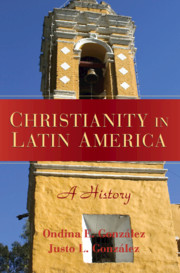Book contents
- Frontmatter
- Contents
- Preface
- Introduction
- 1 Foundations
- 2 The Arrival of Christianity
- 3 The Shaping of the Faith
- 4 Reform Movements
- 5 The Church in Turmoil
- 6 The Church's New Place
- 7 Protestant Immigration
- 8 An Expanding Protestant Presence
- 9 Catholicism after Vatican II
- 10 Pentecostalism and Autochthonous Movements
- 11 By Way of Conclusion
- Some Suggestions for Further Reading
- Sources Referenced
- Index
2 - The Arrival of Christianity
Published online by Cambridge University Press: 05 June 2012
- Frontmatter
- Contents
- Preface
- Introduction
- 1 Foundations
- 2 The Arrival of Christianity
- 3 The Shaping of the Faith
- 4 Reform Movements
- 5 The Church in Turmoil
- 6 The Church's New Place
- 7 Protestant Immigration
- 8 An Expanding Protestant Presence
- 9 Catholicism after Vatican II
- 10 Pentecostalism and Autochthonous Movements
- 11 By Way of Conclusion
- Some Suggestions for Further Reading
- Sources Referenced
- Index
Summary
As we have seen in Chapter 1, in the process of bringing Christianity to the Indies, the Spanish conquistadores laid waste to the high civilizations of the Americas in the name of Christianity. They carried the sword and the cross, transporting across the Atlantic the militant arm of the faith. In their wake came the missionaries who also largely represented the same aggressive church. Yet, as we have also seen, the church was not necessarily of one accord.
Just as with Columbus, whose deep piety and eagerness to bring the love of Christ to heathen prompted him, at least in part, to cross the Atlantic, a ceaseless, deep-felt love for Christ brought many missionaries to the New World: love of a Christ who suffered, endured ridicule, and sacrificed. That Christ would also be the role model for others who also migrated across the Atlantic to bring their faith to the newly encountered lands. Unfortunately, we cannot categorize all action by church representatives in the Americas as selfless and other-serving. For every missionary who treated the Indians with the gentle hand of persuasion, there were others who used the brutal hand of coercion. As we will see, some of the varied responses to the indigenous populations came from the missionaries' own understanding of their role vis-à-vis the conversion of pagans to Christianity, but some came out of frustration and confusion over expectations that were not easily met.
- Type
- Chapter
- Information
- Christianity in Latin AmericaA History, pp. 40 - 63Publisher: Cambridge University PressPrint publication year: 2007



